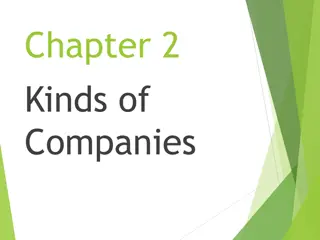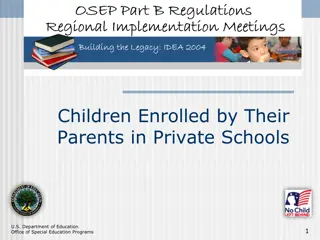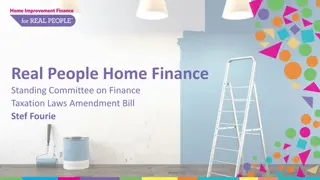Private Finance Capacities Day
The crucial role of the private sector in planning and mobilizing investments aligned with Nationally Determined Contributions (NDCs) to tackle climate change. Discover opportunities, instruments, and finance options available for private sector engagement.
Download Presentation

Please find below an Image/Link to download the presentation.
The content on the website is provided AS IS for your information and personal use only. It may not be sold, licensed, or shared on other websites without obtaining consent from the author. Download presentation by click this link. If you encounter any issues during the download, it is possible that the publisher has removed the file from their server.
E N D
Presentation Transcript
Private Finance Capacities Day THE ROLE OF THE PRIVATE SECTOR THE ROLE OF THE PRIVATE SECTOR IN PLANNING AND MOBILIZING NDC MOBILIZING NDC- -ALIGNED INVESTMENTS ALIGNED INVESTMENTS Joaquim Leite, Head of Climate Finance, NDC Partnership Support Unit IN PLANNING AND
Global Challenge: Aligning Action Today With 1.5 Despite progress, global commitment and stronger alignment are urgently needed to avert a high-risk climate future. Substantial shift needed in financial flows: ~$5 trillion per year. (State of Climate Action, 2023) The lates climate finance data: $8- 10 trillion by 2030-2050. (CPI, 2023) Economic cost of climate change impact is rising: $140-300 billion per year by 2030. From UNFCCC, "Long-term low-emission development strategies: Synthesis report by the secretariat," 26 Oct. 2022.
Climate finance mobilization and acceleration required Global total climate finance: Mobilized $1.27 trillion per year for climate action (640 billion from public and 625 billion from private) The recent estimation reveals we need $5 trillion by 2030, and over 10 trillion by 2050 (CPI, 2023) The gap remains significant E.g., Adaptation finance alone is $387 billion per year, however its gap is $194-366 billion per year (UNEP, 2023)
Private sector engagement Potential adaptation market for private sector is $2 trillion by 2026 (WEF,) *Source: Task Force on Climate Related Financial Disclosures, 2017.
Private sector opportunities, instruments Category Green Finance Instruments Green Loans, Climate Bonds, Green Sukuk, Green Mortgages, Green Banks Sustainable Finance Framework, Taxonomy Climate-related risk management Examples e.g., green loans for renewable energy projects, climate bonds, Islamic bonds, green mortgages for energy-efficient homes e.g., Climate Bond Taxonomy, Gender Bond Framework in line with global standards e.g., climate risk modelling, climate strategy and risk assessment, supply chain risk management, insurance products for climate-related events e.g., Corporate Climate Disclosure Reporting in line with TCFD, Climate Index and scorecards, Risk management Corporate Responsibility, ESG Reporting ESG & Climate-related disclosures and reporting Fintech and Technology Blockchain for Climate Finance e.g., Digital green loan, digital climate wallet for carbon footprint, carbon offset markets, blockchain solutions for carbon credit trading, blockchain for sustainability supply chain e.g., Blended models, Global Innovation Lab for Climate Finance, Impact Investing Funds, Investment Platforms Funds and Investment Blended financing model, Project funding, Crowdfunding
Finance at the NDC Partnership Finance is the most frequently requested area of support among NDC Partnership countries. 85% Members have requested support 127 Partners have provided support 43% Supported 35% Of all requests
Private sector engagement at the NDC Partnership 285 requests related to Private sector (more than 80 countries) Breakdown: Training, Strategy development, engagement of private sector stakeholders Examples of requests: i. Creating a private investment enabling environment in Liberia; ii. Establishing climate change scenario analysis framework and climate stress testing in line with NGFS in Georgia and Jamaica; iii. Developing green financial innovation and climate-integrated risk management frameworks in ECCB; iv. Working with private sector entities to identify gaps, priorities, for private sector involvement in NDC implementation in Antigua and Barbuda; i. Developing a taxonomy, ESG safeguards, and guidance for accessing climate finance in Panama;
Investment Planning at the NDC Partnership In early 2023 the NDC Partnership launched its NDC Investment planning guide. Based on best-practices across the NDC Partnership and in consultation with the private sector. Promotes a programmatic approach to NDC investment planning. Strong focus on the planning for investments. The NDC Partnership partnered with the Green Climate Fund (GCF) to enhance the Guide s framework. The Climate Investment Planning and Mobilization Framework.
The Climate Investment Planning and Mobilization Framework The Framework serves as a non-prescriptive guide, bringing together the collective experience of climate investment planning and mobilization. Provides a common language for countries and finance providers such as the private sector to navigate the progressive steps involved planning and mobilizing climate- aligned investments. The Framework is also designed to facilitate the successful implementation of climate projects, programs, and investments.
The Climate Investment Planning and Mobilization Framework
The Climate Investment Planning and Mobilization Framework Linkages with private sector engagement: Beyond consultation and validation > Co-development The planning process should be aligned with investment frameworks, including those of the private sector M&R of private sector investments > Key in identifying gaps
The Climate Investment Planning and Mobilization Framework Linkages with private sector engagement: Common practices analysis -> Mapping existing solutions and sources of finance is key in prioritizing investments. The results of the cost-benefit analysis should be communicated to financial agents for decision-making as it will will translate climate change risks and opportunities into economic and financial terms.
The Climate Investment Planning and Mobilization Framework Linkages with private sector engagement: Private sources of finance are mapped, including the investment criteria, risk profiles, and characteristics (such as the level of concessionality) associated Comprehensive analysis of existing pipelines to determine the status of each investment requirement, its alignment with the preferences and objectives of potential financiers. Address barriers for private sector investments
The Climate Investment Planning and Mobilization Framework Linkages with private sector engagement: Collaborative work between countries and the private sector to develop project concepts and structure investments. Catalyze private sector participation in climate-aligned investments.
Thank you for your attention www.ndcpartnership.org @ndcpartnership NDC Partnership @ndcpartnership NDC Partnership NDC Partnership
Private Finance Capacities Day GCF/NDC Partnership Climate Investment Planning and GCF/NDC Partnership Climate Investment Planning and Mobilization Framework Mobilization Framework Selina Wrighter, Head of Policy and Strategy at the Green Climate Fund


























